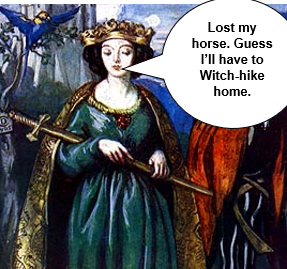Whilst history might remember William III as an “ogre”, his wife, Matilda de St Valery, was dubbed a giantess and witch.
She owned her own castle, which folklore claims that she built singled handed in one night! It is said she carried the stones in her apron, but one got stuck in her slipper. She flicked it out over the River Wye, three miles away where it survives to this day as a nine foot tall standing stone at Llowes Church.
Although the Ogre’s eldest son William (Getting boring now) had died in Windsor, he managed to father four sons prior to his passing; John, Giles, Phillip and Walter. The eldest of these, John (Yes! Not another William), managed to reclaim the Baronies of of both Gower and Bramber with the help of his uncle, Reginald de Braose (for a fee of course). This established John’s branch of the family, and positioned it for survival.
It was around this time that Bramber Castle was returned to the de Braose family, although not after considerable renovations by the King.
The middle son, Giles, exiled in France until 1213, was also the Bishop of Hereford from 1200, to his death in 1215. He managed to make peace with King John, and agreed terms for reclaiming the remaining de Braose lands, but had also made alliances with the Welsh leader, Prince Llywelyn the Great (the same one who his father had aided in the rebellion).
Unfortunately, Giles died before he could come back into his lands.
It was the third son, Reginald, that was able to reacquire the rest of his father’s lands and titles. He opted not for the political approach, but instead simply reclaimed them with brute force, following the death of his brother Giles.
Reginald did not in fact make peace with the Crown until 1217, when the crown passed to King John’s son, Henry III. This in turn was not received well by Llywelyn the Great, current enemy of the crown at the time, and the seeming deceitfulness caused the Welsh to attack de Braose Lands in Brecon, Abergavenny and Gower. Abergavenny Castle had to be rebuilt as a result.
